The Dark Knights True Arch-Nemesis, Ra’s Al Ghul
Ra’s Al Ghul, created by Dennis O’Neal and Neal Adams, first appeared in the pages of Batman #232 in June of 1971. Ra’s Al Ghul’s history in the DC universe is amongst the more interesting of the DC pantheon. Though Ra’s Al Ghul is significantly younger than many of Batman’s villains, his intellect, physical prowess, criminal capabilities, and relationship with Batman make him the perfect villain for the Dark Knight, something the all-star team of Dennis O’Neil and Neal Adams seem to have intended when they created the character.
Ra’s Al Ghul Quick Facts
- Ra’s Al Ghul is an eco-terrorist, a master martial artist, a master swordsman, and a brilliant tactician
- Ra’s Al Ghul boasts an intellect that rivals the Caped Crusader himself. In fact, Ra’s Al Ghul’s mind functions on such a high level that he deduced Batman secret identity in his very first appearance. Ra’s Al Ghul’s first words to Batman in Batman #232 are, “Welcome home, Bruce Wayne — or shall I address you as the Batman?” Ra’s, realizing what equipment Batman would require, tracked specific items to Bruce Wayne.
- Ra’s eventually took to calling Batman/Bruce Wayne “The Detective,” the title seems to be used in admiration of Batman’s deductive abilities.
- Ra’s believes that humanity is a blight on the world and should be extinguished.
- According to DC comics Ra’s Al Ghul’s name directly translates to “Demon’s Head” or “Head of the Demon.”
- Ra’s Al Ghul achieves immortality through the use of Lazarus Pits, an allusion to the story of Lazarus of Bethany who is raised from the dead by Jesus Christ in the Gospel of John.
Origin
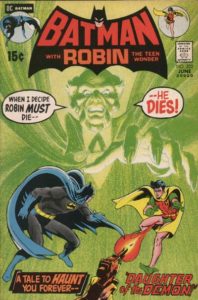
Ra’s Al Ghul’s Origins, which can be found in the “Birth of the Demon” storyline by Dennis O’Neil and Norm Breyfogle compiled in the Batman: Birth of the Demon trade paperback, date back four hundred and fifty to six hundred years, depending on the source. In Azrael #6 (1995) Ra’s Al Ghul tells Jean Paul Valley, “I appear to be a vigorous fifty. I am actually a very vigorous four hundred and forty-eight…or is it four hundred and fifty-three? I lost count during the Black Plague. No matter.” Since this is right from the mouth of the Demon Head himself, it is probably the best time frame to use. Ra’s was born an unnamed child in Arabia to parents of a nomadic tribe. Desiring to lead a life devoted to scientific research Ra’s decides to leave his tribe to reside in an unspecified Middle Eastern city, where he meets and marries the love of his life Sora. Ra’s becomes a physician in this city and discovers his first Lazarus Pit. The King of the Arabian city seeks Ra’s Al Ghul’s help in curing his son. Upon using the Lazarus pit, Ra’s saves the prince. However, the prince goes mad and kills Sora. The King blames the prince’s new behavior on Ra’s and sentences him to torture and death in the same cage as Sora’s corpse. Ra’s is saved by the son of an old woman he previously tried to help. Ra’s, with the help of his uncle and the man who freed him, infects the prince with a disease by contaminating various fabrics and sending them to the prince. The King then seeks the aid of Ra’s Al Ghul to cure his son again. Ra’s refuses, kills both the prince and the king, and leads his tribe through the city walls to exterminate all the city’s inhabitants. Ra’s then declares himself the “Demon’s Head.” Ra’s spends the next few centuries traveling the world. Ra’s creates “The Demon,” a criminal organization with many smaller groups. The chief subsidiary of “The Demon” is “The League of Assassin,” Ra’s Al Ghul’s preferred association. Eventually, Ra’s remarries a woman named Melisande, has two daughters (Nyssa and Talia), has a son who is referred to as “The White Ghost,” and a grandson by Bruce Wayne and Talia Al Ghul named Damian. Damian is the current Robin. Starting in Batman #232, Ra’s Al Ghul spends most of his time trying to wipe out mass amounts of humanity or challenging Batman.
Inception
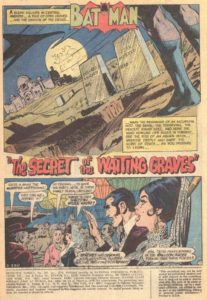
The creation of Ra’s Al Ghul, by Dennis O’Neal and Neal Adams, is as interesting as the character’s origin. In January of 1970 DC comics published the Batman tale “The Secret of the Waiting Greaves” in Detective Comics #395. This story would change Batman from the campy character found in the 1966 TV series to a character more analogous to the Batman known today. According to Dennis O’Neil, “That story was a conscious desire to break out of the Batman TV show; to throw in everything and announce to the world, ‘Hey, we’re not doing camp.’ We wanted to reestablish Batman not only as the best detective in the world, and the best athlete, but also as a dark and frightening creature – if not supernatural, then close to it, by virtue of his prowess.” (Quoted in Sam Hamm’s introduction to the 1991 edition of Batman: Tales of the Demon). Dennis O’Neil and Neil Adams, during the rest of 1970 and first half of 1971, gave comicdom a darker and more serious Batman than had been seen in the sixties. The all-star duo also re-established the Joker as a true psychopath.
Eventually, O’Neil and Adams wanted to give the Dark Knight a new and equal adversary. As Dennis O’Neil said, “There was no doubt that Batman needed a worthy opponent. We set out consciously and deliberately to create a villain in the grand manner, a villain who was exotic and mysterious that neither we nor Batman were sure what to expect.” (Quoted in Sam Hamm’s introduction to the 1991 edition of Batman: Tales of the Demon). In June of 1971 DC Comics published Batman #232, which introduced the world to Ra’s Al Ghul. With Batman #232 and the following forty-one years of Ra’s Al Ghul appearances, comic fans were treated to a villain that matched the Caped Crusader both intellectually and physically. A match not found before in the previous exploits of the Dark Knight.
A Perfect Match
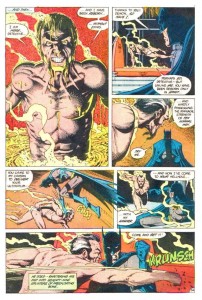
In essence, O’Neil and Adams had created the perfect Villain for Batman. Prior to Ra’s Al Ghul’s inception Batman did not have an antagonist that equaled him on every level. Villains like the Riddler matched the Dark Knight in intellect, but would be sorely outmatched in a physical confrontation. A rogue like Catwoman could match the Caped Crusader blow for blow, but would be bested in an intellectual skirmish. Ra’s Al Ghul, however, would be able to match Batman in a clash of the minds or a physical duel. Ra’s Al Ghul was the first of the Dark Knight’s extensive pantheon of villains to equal him on every level.
Ra’s Al Ghul is not simply limited to murder, theft, etc… as the previous members of Batman’s rogues’ gallery. Ra’s is set on world domination, mass genocide, and finding his intellectual and physical counterpart in Batman. As Sam Hamm says in the introduction to the 1991 edition of Batman: Tales of the Demon, “Where standard villains confined their activities to robbery, revenge and the like, Ra’s’s schemes were at the once more ambitious and more nebulous. He hinted darkly at a “new world order,” and his encounters with Batman often seemed only marginally relevant to an infinitely larger master plan. The Darknight Detective often found himself a pawn in some dimly-perceived game of intrigue and conspiracy, played out across continents, the participants shadowy factions whose ultimate goals we would never discern.”
This adversarial relationship between Batman and Ra’s Al Ghul is analogous to the first super- villain/hero relationship, James Moriarty and Sherlock Holmes, found in the pages of Sir Arthur Conan Doyle’s immortal detective stories. Moriarty sought larger ends yet still remained obsessed with his arch-nemesis Sherlock Holmes. The relationship of Ra’s Al Ghul and Batman seems to have been formulated along the same path.
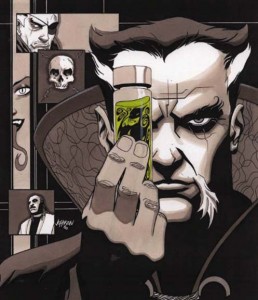
O’Neil and Adams ingeniously went back to the root of the super-villain/hero relationship to create the perfect villain for “The Detective.” The combative, both intellectually and physically, nature of the Batman/Ra’s Al Ghul relationship also contains a component of mutual respect and admiration, another throwback to the relationship of Moriarty and Holmes. As Sam Hamm points out in the introduction to the 1991 edition of Batman: Tales of the Demon, Ra’s’s evil was of a particularly modern type – it sought to co-opt what it could not destroy. Through one subterfuge or another, Ra’s would frequently enlist Batman as a reluctant ally. And, of course, Batman was quite stricken to learn that Ra’s regarded him not only as a deadly adversary, but also a potential successor!” The abundance of respect Ra’s has towards The Caped Crusader can be illustrated in a quote from Nightwing Volume 2 # 152; which can be found in the Nightwing: The Great Leap trade paperback, in which Ra’s laments the supposed death of Batman. “The Bat deserved to meet his doom at my hands — at the hands of someone who hated yet respected him! Mortal enemies deserve at least that. If I was fated to meet my own doom at the Detective’s hands I would have been satisfied — it would have been a good death. It would have been right. It would have been proper. But instead this charade is perpetrated. Gotham and the world should be celebrating the life and death of a man who has pulled them away from the brink of extinction countless times instead of believing their Dark Knight still patrols the city’s streets. A hero of Batman’s caliber should not have perished in the shadows. A hero like Batman should have been killed in the bright light of day for all the world to see. That would have been my final gift to Bruce, a revelation and celebration as I, and I alone, pulled the mask from his lifeless face in victory! Now, as the centuries blow past me like a gentle breeze, I will always mourn the fact that I will not be remembered for killing the Batman, who, after all, would have been the only man I ever killed worth remembering.”
In giving Batman an equal antagonist, both in intelligence and physical prowess, and using the classic literary adversarial relationship as a guide, Dennis O’Neil and Neal Adams created the picture-perfect villain for the Dark Knight. A villain that transcends the typical crimes, often limited to Gotham, of Batman’s previous villains. A villain that challenges Batman’s vow to rid Gotham and the world of crime, as Batman’s victories over Ra’s are always simply curing one symptom of a wide spread disease. A villain, at least in this writer’s opinion, that is the best comic book antagonist DC Comics has ever produced.
Legacy
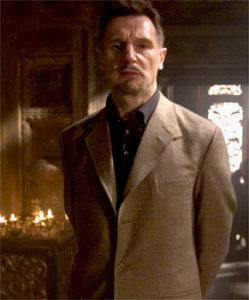
Ra’s Al Ghul has grown, both as a character and in popularity, since the summer of 1971, including his first live action appearance in 2005 in Christopher Nolan’s Batman Begins. In which The Demon’s Head was portrayed brilliantly by Academy Award winning actor Liam Neeson. In addition, Ra’s Al Ghul, once again played by Liam Neeson, is rumored to return in this summer’s most anticipated film, The Dark Knight Rises. It remains to be seen whether the Head of the Demon’s return to the silver screen will be in present day scenes or in flashbacks. The Demon’s Head also made appearances in the beloved 1992-1995 Batman animated series. Ra’s Al Ghul can also be found in the critically acclaimed Batman: Arkham Asylum and Batman: Arkham City video games. Ra’s’s current exploits can be seen in many of the current Bat Family books where he incites havoc in a variety of ways.
Though he began life as a nameless nomad, Ra’s Al Ghul has risen to the top of Batman’s rogues’ gallery. Ra’s deserves to be held in the same esteem as classic DC villains such as Lex Luthor and the Joker. Ra’s will continue to challenge the Dark Knight, and the entirety of the DC universe, for many decades to come. An immense amount of gratitude and admiration are due to Dennis O’Neil and Neal Adams for creating such a dynamic and interesting villain for the Caped Crusader, an antagonist who is both immortal in the DC universe and with comics book fans around the globe.
Recommended Ra’s Al Ghul Reading
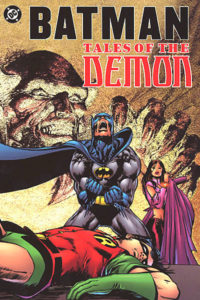 1. Batman: Tales of the Demon by Dennis O’Neil, Neal Adams, et al.
1. Batman: Tales of the Demon by Dennis O’Neil, Neal Adams, et al.
Reissues the early appearances of Ra’s Al Ghul and his infamous daughter Talia.
Mr. Z’s Verdict
Story: 10/10
Art: 10/10
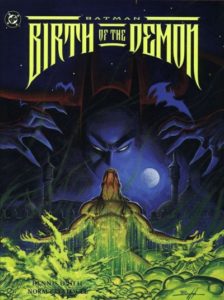 2. Batman: Birth of the Demon by Dennis O’Neil, Mike W. Barr, Norm Breyfogle, Jerry Bingham, and Tom Grindberg
2. Batman: Birth of the Demon by Dennis O’Neil, Mike W. Barr, Norm Breyfogle, Jerry Bingham, and Tom Grindberg
This edition reissues the Demon Trilogy; “The Son of the Demon,” “The Bride of the Demon,” and “The Birth of the Demon.” This trade paperback illustrates a key team-up of Ra’s Al Ghul and Batman, with the intent marrying Batman to Talia Al Ghul. The second story details the Ra’s Al Ghul’s obsession with an heir. The final story arc, where the compilation’s title comes from, tells the tale of Ra’s Al Ghul’s origin, his quest for world domination, and Batman’s pursuit to stop Ra’s Al Ghul from using Lazarus Pits.
Mr. Z’s Verdict
Story: 10/10
Art: 10/10
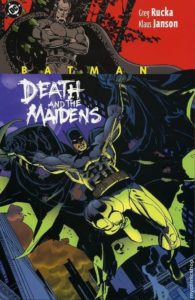 3. Batman: Death and the Maidens by Greg Rucka and Klaus Jenson
3. Batman: Death and the Maidens by Greg Rucka and Klaus Jenson
“Death and the Maidens” centers on Nyssa’s, the prodigal daughter of Ra’s Al Ghul, plot to destroy her father.
Mr. Z’s Verdict
Story: 9/10
Art: 9/10
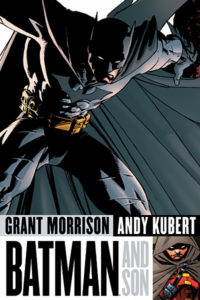 4. Batman and Son by Grant Morrison and Andy Kubert
4. Batman and Son by Grant Morrison and Andy Kubert
This compilation introduces readers to Damian, the son of Bruce Wayne and Talia Al Ghul. Though Ra’s Al Ghul does not appear in this arc, the story links back to the Demon Trilogy and leads up to the “Resurrection of Ra’s Al Ghul” storyline.
Mr. Z’s Verdict
Story: 8/10
Art: 10/10
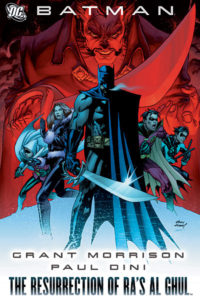 5. Batman: The Resurrection of Ra’s Al Ghul by Grant Morrison, Paul Dini, Tony Daniel, et al.
5. Batman: The Resurrection of Ra’s Al Ghul by Grant Morrison, Paul Dini, Tony Daniel, et al.
This story details the return of Ra’s Al Ghul to the DC universe after the events of “Death and the Maidens.”
Mr. Z’s Verdict
Story: 9/10
Art: 9/10

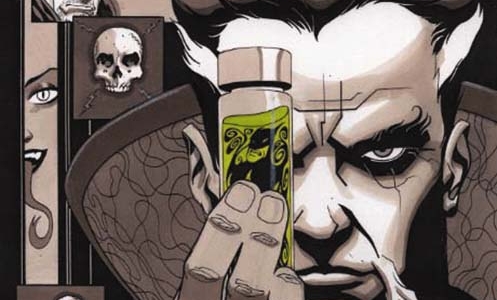
Comment with WordPress, Twitter, or Facebook